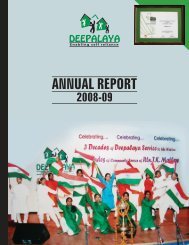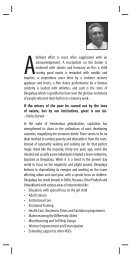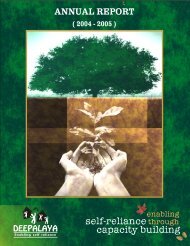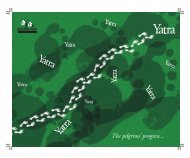Report 2011 - Deepalaya
Report 2011 - Deepalaya
Report 2011 - Deepalaya
You also want an ePaper? Increase the reach of your titles
YUMPU automatically turns print PDFs into web optimized ePapers that Google loves.
PUBLIC WATER – SANITATION OF THE WATER<br />
Picture 1: Scheme of a Tube-Well<br />
Safe drinking water supply plays an important role in prevention of intestinal infectious diseases. “As of 2003, it<br />
was estimated that only 30% of India’s wastewater was being treated. Much of the rest—amounting to millions<br />
of liters each day—find its way into local rivers and streams 26 .” Important impacts on human health are to be<br />
considered as unsafe disposal of human excreta (e.g. open air defecation) facilitates the transmission of fecaloral<br />
diseases through water contamination. According to a survey, 89% of the population in India has access to<br />
safe water but, only 28% has access to adequate sanitation to use it 27 . In this way, even if people have access to<br />
safe drinkable water, poor environmental sanitation is one of the main causes of contamination in water that<br />
increases diseases transmission. An important source of drinkable water in rural areas of India is called Tube<br />
Wells as seen in picture 1.<br />
Tube well is a pipe collecting water from the water-bearing stratum of the soil and it is connected with an<br />
mechanic pump at the top. Water automatically flows out when the tube well is activated and is then stored in<br />
a covered tank from which people take water. It is supposed to be bacteriological safe and it is cheaper than<br />
other water supply. Surroundings 15 m area should be exempt of any pollution e.g. excreta, solid or liquid waste<br />
and living animals to avoid contamination. The pump must be functional, cleaned properly and deeply installed<br />
by engineers in the soil. The life of the tube well is limited even with good repairs, varying on different factors.<br />
Because the tube is not always cleaned properly and pooling water sometimes stays there for a long time,<br />
several bacterias and viruses can develop and live in those tube. Washing clothes or animals, dumping waste<br />
and personal ablutions must be forbidden and top of the reservoir should always be covered to avoid<br />
contamination. In the end, good conditions and utilization of the tube well are essential to get water free from<br />
pathogenic agents and harmful chemicals substances, and keep it uncolored and free of odor 28 .<br />
Knowing all possible routes of contamination of a tube well, it is easy to understand that if the tank is removed<br />
from the top of the pump, a safer access to get drinkable and soil-purified water would be available. It<br />
constitutes a hand-pump working with human power. Nevertheless, this way to obtain water is frequently<br />
considered as being really hard because people have to pump it every time they need. Furthermore, if well built<br />
and if the area surrounding (at least 15 meters) it is kept away from any sources of contamination, studies have<br />
shown marked improvement of bacteriological quality of the water 29 . This would be the safest way to obtain<br />
water without any subsequent treatment such as boiling water.<br />
Boiling water is an efficient way to kill pathogenic agents. A rolling boiled time of 10 to 20 minutes is enough to<br />
26 Reference 9- p.13<br />
27 Reference 2- p. 617- Table 1<br />
28 Reference 2- p. 617- Table 1<br />
29 Reference 2- p. 620







